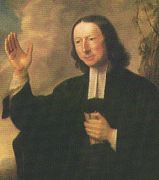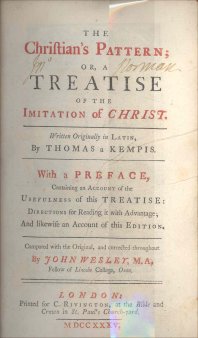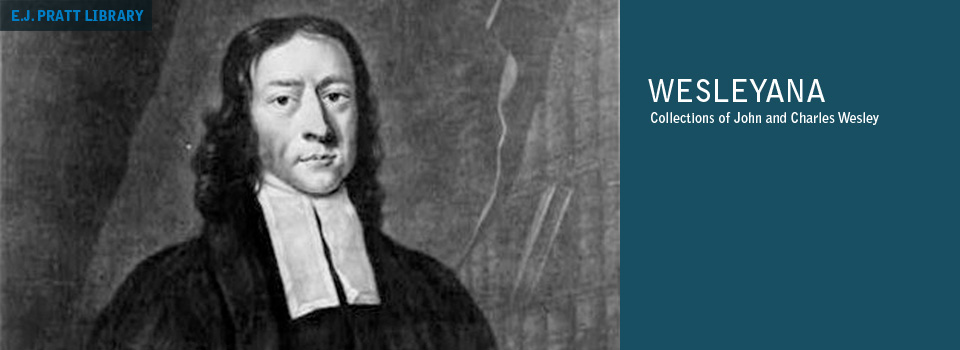Wesleyana Collection
John Wesley (1703-1791)

John Wesley was born on June 28, 1703 at Epworth, England, the fifteenth of nineteen children of Samuel and Susanna Wesley. John received his early education at Charterhouse school and entered Christ Church College, Oxford University in 1720. He was ordained deacon in 1725, and priest in the Church of England in 1728. In 1726, he was elected a Fellow of Lincoln College and lectured in Greek and New Testament Studies. Between 1727 and 1729, he assisted his ailing father at Epworth, but returned to Oxford at the insistence of the authorities, where he joined his brother Charles and several other young scholars in the Holy Club – a discussion group interested in holy living, charity and theological inquiry.
In 1733, he published a book of prayers for each day of the week, and in 1735, published an edition of Thomas A. Kempis', Imitation of Christ, thus beginning a publishing and writing career that spanned half a century.
After the death of his father in 1735, John accepted the chaplaincy in the Colony of Georgia and that same year left with his brother for the Americas. With his knowledge of French, German and Spanish, his mission went well beyond the English settlers in the colony. He translated several German hymns and published a hymn book in Charleston in 1737. However, Wesley's high-church stance and an unfortunate love affair forced him to leave Georgia and return to England in 1738.On May 24, 1738, John Wesley had a major conversion experience at Aldersgate in London which stimulated a renewed interest in holy living, and his trust in personal salvation – "By grace are you saved through faith". His study of Moravian and Arminian theology, as well as the Bible and the Church Fathers, further strengthened this trust.
In 1739, Wesley began what became a Methodist hall mark – field preaching. Many Church of England churches were closed to Methodist preachers and Wesley followed George Whitefield's example and preached to the miners near Bristol. For fifty years Wesley preached throughout Great Britain in chapels, collieries and farmer's fields, stirring an unimagined religious revival. Denouncing both Anglican formalism and Presbyterian exclusiveness, he redirected Protestantism throughout the English-speaking world.
In 1744, he called together preachers committed to the Wesleyan revival and organized the first annual conference to forge strategy and establish a discipline for the Methodist Society. After his death this conference continued to rule the church organization under the leadership of the Legal One Hundred. During his lifetime, Wesley would not permit the society to form a church distinct from the Church of England or to hold services which competed with Anglican worship. An exception was made in America however, to meet the specific circumstances of post-revolutionary conditions.
In 1784, Wesley ordained Thomas Coke as Superintendent for North America with power to ordain other bishops and priests. At Christmas in 1784, Coke established the Methodist Episcopal Church in Philadelphia and this church oversaw Methodist missions in both the United States and what would later become Canada.
Over his long career, Wesley published hundreds of volumes of sermons, correspondence, journals, hymns and church services. He also edited and published a fifty volume "Christian Library" of important theological works. He edited the Arminian Magazine from 1778 until his death and continued to write on historical, literary, scientific and theological topics.Wesley founded Kingswood school, helped organize the Sunday school movement, worked to abolish slavery in the British Empire and the United States. He fought to improve social conditions of eighteenth century England and to overcome the social immorality of his times. The bulk of his time, however, continued to be taken up with constant traveling and preaching. His life represents an amazing account of service and tireless activity.
Timeline
Some Major Events in John Wesley’s Life:
- 1703 Born at Epworth, Lincolnshire, England, 15th child of Samuel and Susanna Wesley
- 1709 Fire at Epworth Rectory - John Wesley rescued
- 1720 Entered Christ Church College, Oxford
- 1725 Ordained Deacon in the Church of England
- 1726 Elected Fellow of Lincoln College, Oxford
- 1728 Ordained Priest
- 1735 Embarked for Mission in Georgia
- 1738 Arrived back in Great Britain
- 1738 Conversion experience at Aldersgate
- 1739 Began preaching out of doors
- 1742 First "class-meetings" organized, they became a 'germ cell' of the Methodist Society
- 1743 Published his General Rules for the Methodist Societies
- 1744 First Methodist Conference held
- 1747 Began first of several visits to Ireland
- 1748 Opened Kingswood School
- 1778 First Issue of Monthly, Arminian Magazine
- 1784 Legally incorporated Methodist Conference
- 1784 Ordained preachers for USA, led to formation of Methodist Episcopal Church the following Christmas
- 1791 John Wesley dies in London, aged 87
The Christian’s Pattern


(Left image, footnote) Christ also suffered leaving us an Example that we should follow his Steps. 1ST St. Pet. 2.G.21.
The Christian’s pattern, or, A treatise of the Imitation of Christ/written originally in Latin, by Thomas a Kempis; with a preface, containing an account of the usefulness of this treatise, directions for reading it with advantage, and likewise an account of this edition; compared with the original, and corrected throughout by John Wesley.
London: Printed for C. Rivington...,1735.
Note: A translation of: Imitatio Christi
No. 3 1735 Green
